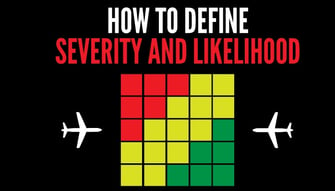
In aviation safety risk management, the risk matrix is a cornerstone tool for identifying, assessing, and prioritizing hazards. It provides a visual framework to evaluate risks based on two key dimensions: severity (the potential impact of a hazard) and likelihood (the probability of occurrence).
While standard risk matrices offer a solid starting point, customizing the severity and likelihood criteria to align with your organization’s unique operational context is critical for effective Safety Management Systems (SMS).
This article explores why aviation safety managers should prioritize customization, offering actionable insights, regulatory context, and practical steps to optimize risk assessment processes.
The Role of the Risk Matrix in Aviation Safety
A risk matrix is a table that plots severity against likelihood to categorize risks into levels (e.g., low, medium, high). In aviation, where safety is paramount, the risk matrix helps safety managers:
-
Identify Hazards: Pinpoint potential safety issues, from mechanical failures to human errors.
-
Assess Risks: Evaluate the potential consequences and probability of incidents.
-
Prioritize Actions: Allocate resources to mitigate high-priority risks.
-
Ensure Compliance: Meet standards set by the International Civil Aviation Organization (ICAO) Annex 19 and national regulators like the FAA or EASA.
Standard risk matrices, often provided in SMS templates from ICAO’s Safety Management Manual (Doc 9859) or FAA’s SMS Voluntary Program, use generic criteria. For example, severity might range from “negligible” to “catastrophic,” and likelihood from “improbable” to “frequent.” While these frameworks are universally applicable, they may not fully reflect the specific risks faced by your organization, whether you’re managing a commercial airline, a general aviation operation, or an airport.
Customizing severity and likelihood criteria ensures the risk matrix is relevant, actionable, and aligned with your operational environment, regulatory requirements, and safety culture. Below, we delve into the key reasons for customization and how to implement it effectively.
Related Articles on Aviation SMS Risk Matrix
- What Is a Risk Matrix and Risk Assessment in Aviation SMS
- How to Define Severity and Likelihood Criteria on Your Risk Matrix
- How to Create Your Risk Matrix for Risk Assessments in Aviation SMS
Why Customize Severity and Likelihood Criteria?
1. Reflect Your Operational Context
Aviation operations vary widely—airlines face different risks than heliports, and cargo carriers differ from business aviation. A one-size-fits-all risk matrix may fail to capture the nuances of your environment.
-
Example: For a regional airline operating small turboprops, a “catastrophic” severity might involve a single aircraft accident with 50 passengers. For a major airline with wide-body jets, “catastrophic” could mean a crash involving 300+ passengers. Customizing severity criteria to reflect fleet size, passenger volume, or operational scope ensures accurate risk assessment.
-
Likelihood Considerations: A general aviation operator in a remote region might classify icing-related hazards as “frequent” due to local weather patterns, whereas a tropical airport might rate them as “improbable.” Tailoring likelihood criteria to your geography and climate improves precision.
Benefit: A customized risk matrix mirrors your operational realities, making risk assessments more relevant and actionable.
2. Enhance Regulatory Compliance
Regulators like ICAO, FAA, and EASA require SMS frameworks to be tailored to the organization’s size, complexity, and risk profile. Generic risk matrices may not satisfy these requirements.
-
ICAO Annex 19: Emphasizes that SMS must be “appropriate to the size and complexity” of the organization. Customized risk criteria demonstrate that your SMS is designed for your specific hazards.
-
FAA SMS Rule (14 CFR Part 5): Requires operators to define risk controls based on their unique risk assessments. Tailored severity and likelihood criteria ensure compliance with this mandate.
-
EASA Requirements: European operators must align SMS with their operational context, including specific risk thresholds.
Actionable Insight: During audits, regulators often review risk matrices to ensure they reflect the organization’s risk profile. Customization signals a proactive approach to compliance.
3. Improve Decision-Making and Resource Allocation
A tailored risk matrix provides clearer guidance for prioritizing mitigation efforts, ensuring resources are directed to the most critical risks.
-
Scenario: A generic matrix might classify a runway incursion as “high risk” for all operators. However, an airport with advanced ground radar might lower the likelihood, while a smaller airport without such technology might raise it. Customization ensures accurate prioritization.
-
Resource Efficiency: By aligning severity and likelihood with your operation, you avoid over- or under-allocating resources. For example, a cargo operator might prioritize cargo door failures over passenger-related risks, reflecting their unique concerns.
Benefit: Customized criteria lead to data-driven decisions, optimizing safety investments and operational efficiency.
4. Foster a Strong Safety Culture
A risk matrix that resonates with your team encourages buy-in from frontline staff, management, and stakeholders. Generic criteria can feel disconnected, reducing engagement.
-
Employee Relevance: When severity and likelihood criteria reflect real-world scenarios (e.g., “runway excursion during monsoon season” for a tropical airport), employees are more likely to understand and report hazards.
-
Training and Communication: Customized matrices simplify SMS training by using terminology and examples familiar to your team, reinforcing a proactive safety culture.
Example: A business aviation operator might define “moderate” severity as “damage requiring aircraft grounding for 24 hours,” a scenario pilots and maintenance crews can relate to, increasing their engagement with the SMS.
5. Adapt to Emerging Risks
Aviation is dynamic, with new risks emerging from technology, regulations, or environmental factors. Customized risk matrices are easier to update than rigid, generic ones.
-
Emerging Technologies: The rise of drones or electric aircraft introduces new hazards (e.g., battery fires). Customizing likelihood criteria to account for these technologies ensures your matrix remains relevant.
-
Climate Change: Increasing extreme weather events may shift likelihood ratings for weather-related hazards. A tailored matrix can incorporate these trends.
Pro Tip: Schedule annual reviews of your risk matrix to incorporate new risks and align with industry trends.
Related Aviation SMS Risk Matrix Articles
- How to Define Your Risk Matrix in Aviation SMS
- Guide to Define Risk Matrix Probability and Severity in Aviation Safety
- Safety Chart: How to Monitor Aviation Risk Management Priorities Using Heat Maps
How to Customize Severity and Likelihood Criteria
Customizing a risk matrix is a structured process that involves collaboration, data analysis, and regulatory alignment. Below are practical steps for aviation safety managers.
Step 1: Conduct a Risk Profile Assessment
Understand your organization’s unique risk landscape.
-
Operational Analysis: Identify key operations (e.g., flight operations, ground handling, maintenance) and associated hazards. For example, a cargo operator might prioritize load shift risks, while an airport focuses on bird strikes.
-
Historical Data: Review incident reports, safety audits, and near-miss data to identify recurring hazards and their impacts.
-
Stakeholder Input: Engage pilots, maintenance crews, air traffic controllers, and management to gather insights on perceived risks.
Tool: Use a hazard identification checklist from ICAO’s Safety Management Manual or FAA’s SMS Gap Analysis Tool to guide this process.
Step 2: Define Severity Criteria
Develop severity levels that reflect the potential consequences of hazards in your operation.
-
Categories: Common severity categories include negligible, minor, moderate, major, and catastrophic. Define each based on your context:
-
Negligible: No safety impact (e.g., minor paperwork error).
-
Minor: Slight operational disruption (e.g., delayed flight due to equipment issue).
-
Moderate: Significant disruption or injury (e.g., ground collision with minor injuries).
-
Major: Serious incident (e.g., runway excursion with no fatalities).
-
Catastrophic: Loss of life or aircraft (e.g., mid-air collision).
-
-
Quantitative Metrics: Where possible, tie severity to measurable outcomes, such as repair costs, downtime, or passenger impact. For example, “major” might mean “repair costs exceeding $500,000.”
-
Regulatory Alignment: Ensure definitions align with ICAO Annex 19 or local regulations.
Example: A heliport might define “catastrophic” as “crash with multiple fatalities,” while an airline might include “loss of aircraft and reputational damage.”
Step 3: Define Likelihood Criteria
Establish likelihood levels based on the probability of hazards occurring in your operation.
-
Categories: Common levels include improbable, remote, occasional, probable, and frequent. Define each with qualitative or quantitative measures:
-
Improbable: Less than once in 10 years (e.g., volcanic ash encounter in a non-volcanic region).
-
Remote: Once every 5–10 years.
-
Occasional: Once every 1–5 years.
-
Probable: Once per year.
-
Frequent: Multiple times per year.
-
-
Data-Driven: Use historical incident data or industry benchmarks (e.g., IATA safety reports) to estimate probabilities.
-
Environmental Factors: Account for geography, weather, or traffic density. For example, a busy hub airport might rate runway incursions as “probable,” while a rural airstrip rates them as “remote.”
Tip: Use SKYbrary’s Safety Management Toolkit for sample likelihood definitions.
Step 4: Build the Risk Matrix
Combine severity and likelihood into a matrix, typically 5x5 or 4x4, and assign risk levels (e.g., low, medium, high). SMS Pro allows administrators to modify 5x5, 4x4, 3x3 without requiring technical support. Other matrices like 5x6 would require SMS Pro tech support to customize.
-
Color Coding: Use green (low), yellow (medium), and red (high) to visualize risk levels.
-
Action Thresholds: Define actions for each level. For example:
-
Low: Monitor.
-
Medium: Implement controls within 30 days.
-
High: Immediate action required.
-
-
Customization Example: A general aviation operator might classify “moderate severity, probable likelihood” as “medium risk,” while a major airline might rate it as “high” due to higher passenger volumes.
Tool: Adapt templates from FAA’s SMS Voluntary Program or IATA’s SMS Implementation Guide.
Step 5: Validate and Test
Ensure the customized matrix is practical and compliant.
-
Peer Review: Have safety teams and operational staff review the matrix for clarity and relevance.
-
Scenario Testing: Apply the matrix to past incidents or hypothetical scenarios to verify accuracy. For example, test how a “bird strike” is rated and whether the outcome aligns with operational priorities.
-
Regulatory Check: Cross-reference with ICAO, FAA, or EASA standards to ensure compliance.
Step 6: Train and Implement
Integrate the customized matrix into your SMS.
-
Training: Educate staff on the matrix using real-world examples. For instance, show how a “frequent” likelihood applies to taxiway congestion at your airport.
-
Integration: Embed the matrix in safety reporting tools, risk assessments, and audits.
-
Continuous Improvement: Collect feedback from users to refine criteria over time.
Resource: Join LinkedIn groups like "Aviation Safety Management Systems," “Aviation Safety Professionals” or follow #SMSImplementation on X for peer insights on matrix customization.
Challenges and Solutions
Customizing a risk matrix isn’t without challenges. Here are common pitfalls and how to address them:
-
Challenge: Overcomplicating criteria, leading to confusion.
-
Solution: Keep definitions simple and use examples relevant to your operation.
-
-
Challenge: Lack of data to define likelihood.
-
Solution: Leverage industry reports (e.g., NBAA safety data) or consult with peers at conferences like the World Aviation Safety Summit.
-
-
Challenge: Resistance to change from staff accustomed to generic matrices.
-
Solution: Highlight the benefits of customization (e.g., better resource allocation) and involve staff in the customization process.
-
Conclusion
Customizing severity and likelihood criteria on your risk matrix is not just a regulatory requirement—it’s a strategic necessity for aviation safety managers.
A tailored matrix reflects your operational context, enhances compliance, improves decision-making, fosters a safety culture, and adapts to emerging risks. By following a structured process—assessing your risk profile, defining criteria, building the matrix, and validating it—you can create a tool that drives effective risk management.
Start by reviewing your current risk matrix against your operational hazards. Leverage resources from ICAO, FAA, IATA, or SKYbrary to guide customization. Engage your team to ensure buy-in and regularly update the matrix to stay ahead of new risks. With a customized risk matrix, you’ll strengthen your SMS, protect your operation, and uphold the highest standards of aviation safety.





